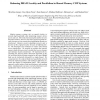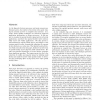HPCA
2012
IEEE
13 years 3 months ago
2012
IEEE
Modern memory systems rely on spatial locality to provide high bandwidth while minimizing memory device power and cost. The trend of increasing the number of cores that share memo...
ICCV
2011
IEEE
13 years 7 months ago
2011
IEEE
Invariant representations in object recognition systems are generally obtained by pooling feature vectors over spatially local neighborhoods. But pooling is not local in the featu...
FAST
2011
13 years 11 months ago
2011
Exploiting spatial locality is critical for a disk scheduler to achieve high throughput. Because of the high cost of disk head seeks and the non-preemptible nature of request serv...
PDCN
2004
14 years 8 months ago
2004
We present a family of methods for speeding up distributed locks by exploiting the uneven distribution of both temporal and spatial locality of access behaviour of many applicatio...
MICRO
1997
IEEE
14 years 11 months ago
1997
IEEE
As the disparity between processor and main memory performance grows, the number of execution cycles spent waiting for memory accesses to complete also increases. As a result, lat...
ISCA
1998
IEEE
14 years 11 months ago
1998
IEEE
Modern cache designs exploit spatial locality by fetching large blocks of data called cache lines on a cache miss. Subsequent references to words within the same cache line result...
IEEEPACT
1999
IEEE
14 years 11 months ago
1999
IEEE
The performance of applications on large shared-memory multiprocessors with coherent caches depends on the interaction between the granularity of data sharing, the size of the coh...
ACMMSP
2004
ACM
15 years 27 days ago
2004
ACM
Irregular applications frequently exhibit poor performance on contemporary computer architectures, in large part because of their inefficient use of the memory hierarchy. Runtime ...
VLDB
2005
ACM
15 years 29 days ago
2005
ACM
In recent years, the wide availability of personal data has made the problem of privacy preserving data mining an important one. A number of methods have recently been proposed fo...
MICRO
2006
IEEE
15 years 1 months ago
2006
IEEE
We present Adaptive Stream Detection, a simple technique for modulating the aggressiveness of a stream prefetcher to match a workload’s observed spatial locality. We use this co...





